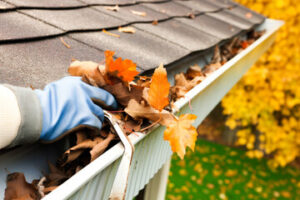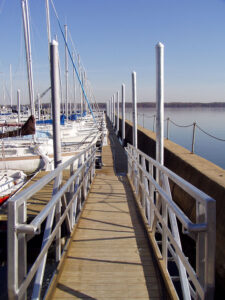Gutter Cleaning Sarasota FL is a necessary home maintenance task that protects your roof, walls, and foundation from water damage. Clogged gutters can’t channel rainwater properly and can cause soil erosion, as well as stains on your house and garden.

Sitting water can also attract rodents and insects. Professionals use specialized tools to eliminate clogs and help prevent future problems.
Gutters are a key component of a home’s water management system. They funnel rainwater from your roof down through a downspout to the ground, directing water away from your foundation and basement to prevent costly damage. However, gutters are also prone to collecting debris such as leaves, twigs, and dirt. These obstructions clog your gutter systems, blocking the flow of rainwater and potentially leading to roof or foundation damage. Gutter cleaning involves removing this debris, ensuring free water flow through your gutters, and minimizing the risk of future clogs.
Gutter cleaning is a vital service that can prevent significant property damage, minimize health risks, and extend the lifespan of your gutters. Moreover, this service can help you save money on costly home repairs and maintain the value of your property. In addition, regular gutter cleaning ensures that your landscaping thrives. It protects your trees from root rot and helps keep plants healthy. A clogged gutter, on the other hand, can cause soil erosion and sweep away your beautiful flowers.
Gutter cleaning involves a thorough inspection of your entire gutter system, including the downspouts, to identify any potential issues. The inspector can also recommend any repairs necessary to keep your gutters functional. The process typically takes one to two hours and varies depending on the size of your property and the level of debris accumulation. A professional can use a ladder to reach the highest parts of your roof, scoop debris into a garbage bag, and flush the gutters with a hose or power washer.
Another important function of gutters is to avoid basement flooding, which can ruin furniture, electronics, and other valuables stored in your basement. If you notice pooling water or damp spots in your basement, it may indicate a clogged or blocked gutter that needs to be cleaned or repaired. In addition, clogged gutters can lead to mold and mildew growth, which can be a health hazard for your family. By implementing a regular maintenance schedule and establishing an effective cleaning routine, you can minimize basement flooding and other gutter-related issues.
Downspout Cleaning
Gutters and downspouts play an important role in protecting your home from water damage by directing rainwater away from the exterior walls of your house. But over time, leaves, twigs and dirt can build up in the gutters and downspouts causing clogs. Clogged downspouts can cause water to overflow and seep into the walls of your house, resulting in structural damage and costly repairs. Regular cleaning and maintenance will prevent these problems.
One of the most important reasons to keep your gutters and downspouts clean is to protect your foundation from water damage. Water damage can weaken the foundation of your home and lead to cracks, rot and mold. Gutter and downspout cleaning will help ensure that rainwater is diverted from the foundation of your home, preventing this water damage.
Another reason to keep your gutters and downspouts properly maintained is to avoid the formation of ice dams during the winter. When gutters are clogged, the water will collect and freeze, causing ice dams along the edge of the roof and leaking into your home. This can result in expensive repairs and restoration. Gutter and downspout cleaning can prevent these issues by ensuring that the system is free-flowing throughout the year.
When cleaning your gutters, start by removing all the debris that is easily accessible from the top of the downspout. Next, remove the downspout extension and use a garden trowel to dislodge any remaining debris that is stuck. Finally, rinse the downspout with a hose to make sure it is completely clean and free of debris. If you can, consider installing a downspout filter at the bottom of the downspout to reduce the occurrence of clogs and allow for easier cleaning without using a ladder. For best results, it is recommended that you clean your gutters twice a year, in the spring and fall. However, depending on the number of trees around your home and the amount of rainfall in your area you may need to perform more frequent gutter cleaning. By following these simple steps, you will extend the life of your gutters and ensure that they are functioning correctly.
Ladder Safety
Gutter cleaning is a laborious task that requires climbing a ladder and working at heights. Ladder safety is crucial, and each year thousands of individuals experience injuries related to improper ladder handling. Luckily, there are simple steps you can take to ensure safe and efficient gutter maintenance.
Ladders should be inspected for obvious signs of damage and should have an appropriate load capacity. You should also examine the stability of ladder feet for even contact on ground surfaces and slopes. You should also check for the proper angling of your ladder, following the “4-to-1 rule” (for every four feet in ladder height, the base should sit one foot away from the wall).
Suitable clothing can improve both comfort and safety while cleaning gutters. Long sleeves and pants prevent debris from coming into direct contact with your skin, reducing the risk of rashes and cuts as you press up against ladder sides and lean over roof edges. Additionally, safety gloves can protect your hands from abrasive materials such as rotting leaves and bird droppings. Finally, rubber-soled work shoes can help ward off slips on ladder stiles and rungs.
Gutter gunk can be slippery, so you should always dispose of it in a bucket or on the ground. This eliminates the risk of sliding off the ladder and falling off a roof or onto the surrounding landscaping below. In addition, you can use a painter’s bucket hook to hang the bucket from the top of your ladder for easy access.
When using the ladder, you should keep both hands firmly on it at all times to avoid overreaching and losing your balance. It’s a good idea to have a spotter hold the ladder while you’re working at heights, and to use a harness for added protection in case of a fall. Additionally, you should wear a hard hat to prevent head injuries from falling objects. In addition, a pair of safety glasses can help protect your eyes from the glaring sun. You should also avoid using power tools while on a ladder, as they can increase the risk of falls and other injuries.
Safety First
Gutter cleaning is one of the most unpleasant chores associated with home ownership. However, this is a critical home maintenance task that should be performed at least once per year. Gutter systems funnel rainwater and melting snow away from the house, preventing it from spilling over the sides of the building.
If left unattended, overflowing gutters can cause basement flooding. This water can damage furniture, electronics and other items housed in the basement. It can also fuel the growth of mold, mildew and other contaminants that pose health risks for those living in the home. Gutter cleaning minimizes this risk by ensuring that the gutter system is free of blockages that prevent proper flow.
When performing gutter cleaning, it is important to consider ladder safety. Falling from a ladder can be extremely dangerous, and even deadly. Each year, thousands of people are treated for ladder-related injuries and as many as 300 die. Ladder safety is especially crucial for older homeowners who may be at greater risk of a fall. To minimize the danger of falling from a ladder, it is essential to always place it on stable ground and have someone spot you while you work.
During gutter cleaning, it is also essential to wear gloves and eye protection. Gloves protect hands from dirty, rotting leaf debris that can contain rodent droppings and other bacteria. Wearing eye protection will help to reduce the risk of an accident caused by flying debris. Eye protection is also recommended when using a power washer to clear gutters. This tool can be very dangerous if not used properly and can spray water at high speeds that can injure or kill people or pets.
To prevent accidents, it is recommended to start on a small section of the gutter at a time and work your way up, ensuring that you are completely finished with each area before moving onto the next. Once the gutters and downspouts are cleaned, a final inspection should be done to ensure that all of the debris was removed. Once the inspection is complete, the clogged material should be bagged and disposed of properly.
